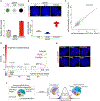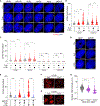Identification of modulators of the ALT pathway through a native FISH-based optical screen
- PMID: 39729394
- PMCID: PMC11844024
- DOI: 10.1016/j.celrep.2024.115114
Identification of modulators of the ALT pathway through a native FISH-based optical screen
Abstract
A significant portion of human cancers utilize a recombination-based pathway, alternative lengthening of telomeres (ALT), to extend telomeres. To gain further insights into this pathway, we developed a high-throughput imaging-based screen named TAILS (telomeric ALT in situ localization screen) to identify genes that either promote or inhibit ALT activity. Screening over 1,000 genes implicated in DNA transactions, TAILS reveals both well-established and putative ALT modulators. Here, we present the validation of factors that promote ALT, such as the nucleosome-remodeling factor CHD4 and the chromatin reader SGF29, as well as factors that suppress ALT, including the RNA helicases DExD-box helicase 39A/B (DDX39A/B), the replication factor TIMELESS, and components of the chromatin assembly factor CAF1. Our data indicate that defects in histone deposition significantly contribute to ALT-associated phenotypes. Based on these findings, we demonstrate that pharmacological treatments can be employed to either exacerbate or suppress ALT-associated phenotypes.
Keywords: ALT; CP: Molecular biology; DDX39A; histone deposition; ssTelo; telomeres.
Published by Elsevier Inc.
Conflict of interest statement
Declaration of interests The authors declare no competing interests.
Figures





Update of
-
Identification of Novel Modulators of the ALT Pathway Through a Native FISH-Based Optical Screen.bioRxiv [Preprint]. 2024 Nov 15:2024.11.15.623791. doi: 10.1101/2024.11.15.623791. bioRxiv. 2024. Update in: Cell Rep. 2025 Jan 28;44(1):115114. doi: 10.1016/j.celrep.2024.115114. PMID: 39605432 Free PMC article. Updated. Preprint.
References
-
- Perera SA, Maser RS, Xia H, McNamara K, Protopopov A, Chen L, Hezel AF, Kim CF, Bronson RT, Castrillon DH, et al. (2008). Telomere dysfunction promotes genome instability and metastatic potential in a K-ras p53 mouse model of lung cancer. Carcinogenesis 29, 747–753. 10.1093/carcin/bgn050. - DOI - PubMed
Publication types
MeSH terms
Substances
Grants and funding
LinkOut - more resources
Full Text Sources
Miscellaneous

